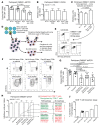Latent HIV reservoirs exhibit inherent resistance to elimination by CD8+ T cells
- PMID: 29355843
- PMCID: PMC5785246
- DOI: 10.1172/JCI97555
Latent HIV reservoirs exhibit inherent resistance to elimination by CD8+ T cells
Abstract
The presence of persistent, latent HIV reservoirs in CD4+ T cells obstructs current efforts to cure infection. The so-called kick-and-kill paradigm proposes to purge these reservoirs by combining latency-reversing agents with immune effectors such as cytotoxic T lymphocytes. Support for this approach is largely based on success in latency models, which do not fully reflect the makeup of latent reservoirs in individuals on long-term antiretroviral therapy (ART). Recent studies have shown that CD8+ T cells have the potential to recognize defective proviruses, which comprise the vast majority of all infected cells, and that the proviral landscape can be shaped over time due to in vivo clonal expansion of infected CD4+ T cells. Here, we have shown that treating CD4+ T cells from ART-treated individuals with combinations of potent latency-reversing agents and autologous CD8+ T cells consistently reduced cell-associated HIV DNA, but failed to deplete replication-competent virus. These CD8+ T cells recognized and potently eliminated CD4+ T cells that were newly infected with autologous reservoir virus, ruling out a role for both immune escape and CD8+ T cell dysfunction. Thus, our results suggest that cells harboring replication-competent HIV possess an inherent resistance to CD8+ T cells that may need to be addressed to cure infection.
Keywords: AIDS/HIV; Drug therapy; Immunology; T cells.
Conflict of interest statement
Figures






Similar articles
-
Maraviroc Is Associated with Latent HIV-1 Reactivation through NF-κB Activation in Resting CD4+ T Cells from HIV-Infected Individuals on Suppressive Antiretroviral Therapy.J Virol. 2018 Apr 13;92(9):e01931-17. doi: 10.1128/JVI.01931-17. Print 2018 May 1. J Virol. 2018. PMID: 29444937 Free PMC article.
-
TLR1/2 Agonist Enhances Reversal of HIV-1 Latency and Promotes NK Cell-Induced Suppression of HIV-1-Infected Autologous CD4+ T Cells.J Virol. 2021 Aug 10;95(17):e0081621. doi: 10.1128/JVI.00816-21. Epub 2021 Aug 10. J Virol. 2021. PMID: 34133900 Free PMC article.
-
Suppression of HIV replication in the resting CD4+ T cell reservoir by autologous CD8+ T cells: implications for the development of therapeutic strategies.Proc Natl Acad Sci U S A. 2001 Jan 2;98(1):253-8. doi: 10.1073/pnas.98.1.253. Proc Natl Acad Sci U S A. 2001. PMID: 11136258 Free PMC article.
-
Reservoirs for HIV-1: mechanisms for viral persistence in the presence of antiviral immune responses and antiretroviral therapy.Annu Rev Immunol. 2000;18:665-708. doi: 10.1146/annurev.immunol.18.1.665. Annu Rev Immunol. 2000. PMID: 10837072 Review.
-
Harnessing CD8+ T Cells Under HIV Antiretroviral Therapy.Front Immunol. 2019 Feb 26;10:291. doi: 10.3389/fimmu.2019.00291. eCollection 2019. Front Immunol. 2019. PMID: 30863403 Free PMC article. Review.
Cited by
-
Adeno-Associated Virus (AAV)-Delivered Exosomal TAT and BiTE Molecule CD4-αCD3 Facilitate the Elimination of CD4 T Cells Harboring Latent HIV-1.Microorganisms. 2024 Aug 18;12(8):1707. doi: 10.3390/microorganisms12081707. Microorganisms. 2024. PMID: 39203549 Free PMC article.
-
Inhibition of major histocompatibility complex-I antigen presentation by sarbecovirus ORF7a proteins.Proc Natl Acad Sci U S A. 2022 Oct 11;119(41):e2209042119. doi: 10.1073/pnas.2209042119. Epub 2022 Sep 22. Proc Natl Acad Sci U S A. 2022. PMID: 36136978 Free PMC article.
-
Phenotypic signatures of immune selection in HIV-1 reservoir cells.Nature. 2023 Feb;614(7947):309-317. doi: 10.1038/s41586-022-05538-8. Epub 2023 Jan 4. Nature. 2023. PMID: 36599977 Free PMC article.
-
HTLV-1 as a Model for Virus and Host Coordinated Immunoediting.Front Immunol. 2019 Sep 24;10:2259. doi: 10.3389/fimmu.2019.02259. eCollection 2019. Front Immunol. 2019. PMID: 31616431 Free PMC article.
-
mTOR signaling mediates effects of common gamma-chain cytokines on T cell proliferation and exhaustion: implications for HIV-1 persistence and cure research.AIDS. 2018 Nov 28;32(18):2847-2851. doi: 10.1097/QAD.0000000000001997. AIDS. 2018. PMID: 30234610 Free PMC article.
References
Publication types
MeSH terms
Substances
Grants and funding
LinkOut - more resources
Full Text Sources
Other Literature Sources
Medical
Research Materials

